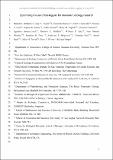Optimizing the use of biologgers for movement ecology research
Abstract
1.The paradigm-changing opportunities of biologging sensors for ecological research, especially movement ecology, are vast, but the crucial questions of how best to match the most appropriate sensors and sensor combinations to specific biological questions, and how to analyse complex biologging data, are mostly ignored. 2.Here, we fill this gap by reviewing how to optimise the use of biologging techniques to answer questions in movement ecology and synthesise this into an Integrated Biologging Framework (IBF). 3.We highlight that multi-sensor approaches are a new frontier in biologging, whilst identifying current limitations and avenues for future development in sensor technology. 4.We focus on the importance of efficient data exploration, and more advanced multi-dimensional visualisation methods, combined with appropriate archiving and sharing approaches, to tackle the big data issues presented by bio-logging. We also discuss the challenges and opportunities in matching the peculiarities of specific sensor data to the statistical models used, highlighting at the same time the large advances which will be required in the latter to properly analyse biologging data. 5.Taking advantage of the bio-logging revolution will require a large improvement in the theoretical and mathematical foundations of movement ecology, to include the rich set of high-frequency multivariate data, which greatly expand the fundamentally limited and coarse data that could be collected using location-only technology such as GPS. Equally important will be the establishment of multi-disciplinary collaborations to catalyse the opportunities offered by current and future bio-logging technology. If this is achieved, clear potential exists for developing a vastly improved mechanistic understanding of animal movements and their roles in ecological processes, and for building realistic predictive models.
Citation
Williams , H , Taylor , L , Benhamou , S , Bijleveld , A , Clay , T , de Grissac , S , Demsar , U , English , H , Franconi , N , Gómez-Laich , A , Griffiths , R , Kay , W , Morales , J M , Potts , J , Rogerson , K , Rutz , C , Spelt , A , Trevail , A , Wilson , R & Börger , L 2019 , ' Optimizing the use of biologgers for movement ecology research ' , Journal of Animal Ecology , vol. Early View . https://doi.org/10.1111/1365-2656.13094
Publication
Journal of Animal Ecology
Status
Peer reviewed
ISSN
0021-8790Type
Journal article
Description
Authors acknowledge funding and support by the British Ecological Society, the Swansea Centre for Biomathematics, Wildbytes Ltd., and Swansea University. HJW was supported by the European Research Council under the European Union’s Horizon 2020 research and innovation program Grant 715874 (to E.L.C. Shepard); TAC is funded by a Human Frontier Research Program Young Investigator Grant (SeabirdSound - RGY0072/2017); SdG is funded by the European Regional Development Fund through the Ireland Wales Cooperation programme, BLUEFISH; WPK is supported by the Welsh Government’s European Social Fund (ESF), Natural Resources Wales (NRW) and SEACAMS2 – the latter supports also NF; JRP by the National Environmental Research Council (NERC) grant NE/R001669/1; and KFR is NERC funded PhD via EnvEast DTP. UD is supported by a Leverhulme Trust Research Project Grant (RPG-2018-258).Collections
Items in the St Andrews Research Repository are protected by copyright, with all rights reserved, unless otherwise indicated.

